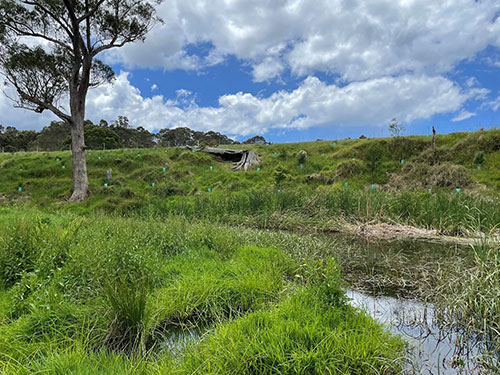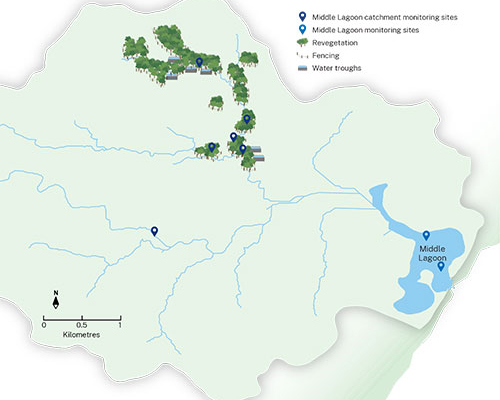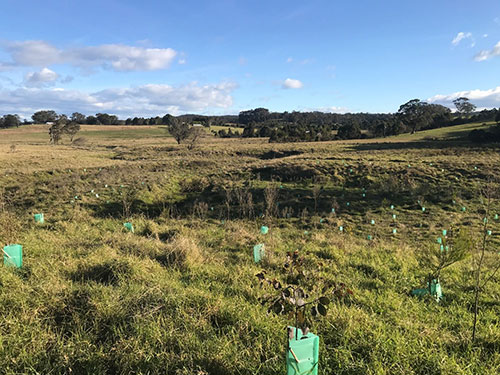MEMS case study - Middle Lagoon catchment
People and partnerships working to transform Middle Lagoon catchment
Local landholders are leading efforts to maintain and improve water quality at Middle Lagoon and its tributaries. With support from Local Land Services (LLS) and the Department of Planning and Environment (DPE), property managers within the Middle Lagoon catchment are improving riparian vegetation to reduce bank erosion and nutrient run off into the lake. These projects are funded by the NSW Government under the Marine Estate Management Strategy (MEMS), a 10-year strategy to coordinate management of the marine estate.
Riparian vegetation, the trees and shrubs that line the fringes of waterways, is incredibly important to the health of streams and coastal lakes. Over time access to creeks has impacted waterway health in a number of ways, including erosion of stream banks, increased nutrient loads and sedimentation, and faecal contamination from livestock waste entering the waterway. As a result, the Middle Lagoon has received highly variable ecological health scores compared to similar coastal lakes and lagoons across NSW.
Landholders are restoring native vegetation on their lands to help improve the condition of these waterways and provide benefits to livestock and properties.

Riparian vegetation planted along Middle Lagoon catchment waterway.
What has been done to restore the lagoon?
- 8,775 trees and shrubs planted
- 5 km of stream length planted with native trees and shrubs
- 14 hectare of riparian land revegetated.
Key findings
Scientists from DPE have assessed several key environmental indicators at tributary creeks to understand the health of the waterway.
- Some sections of the creeks are in relatively poor condition with slumped and eroded stream banks, high concentrations of nutrients (nitrogen and phosphorous) and presence of faecal bacteria.
- Sampling shows the macroinvertebrate (water bug) diversity is impaired at sites lower in the catchment. This suggests these sites are potentially suffering from habitat disturbance and waterway pollution from excess sediment and nutrients.
- The good news is that early monitoring suggests a slight improvement in some water quality indicators following restoration activities at some sites. Further monitoring is required to confirm these trends.

Location of Middle Lagoon catchment riparian vegetation improvement works and monitoring sites.
Recovery over time
Over time it is expected that new vegetation will stabilise creek banks, reduce erosion and shade the creek, creating better habitat for a diversity of species including fish and water bugs. By excluding livestock from waterways around the lagoon, groundcover, bank stability, in-stream vegetation, and water quality will also improve.
It may be some time before lasting change is seen to the environment and ecosystem of Middle Lagoon, but the more community members take an interest in the health of their waterways and make improvements to their land, the greater the results will be.

Native vegetation planted along a cleared waterway in the Middle Lagoon catchment.
Why should you get involved?
There are many benefits of rehabilitating the riparian zone. Not only is it good for the environment in the long run but these works provide social and economic benefits for you and your land.
Get in contact to find out more about restoring the riparian zone on your property, including fencing works, water troughs and planting riparian vegetation.
Download a PDF copy of the Middle Lagoon Catchment case study PDF, 1179.1 KB.
For more information
Get in contact with Leanna Moerkerken, South East Local Land Services
E: leanna.moerkerken@lls.nsw.gov.au
P: 0427 291 798
These projects are funded by the NSW Government under the Marine Estate Management Strategy. The 10-year strategy was developed by the NSW Marine Estate Management Authority to coordinate the management of the marine estate. Visit the NSW Marine Estate website to find out more.